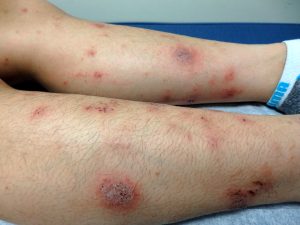Chapter 3: Eczematous Disorders
Nummular Eczema/ Nummular Dermatitis
What is it?
Nummular dermatitis is a form of eczema characterized by coin-shaped eczematous plaques that can occur as a solitary plaque or can be multiple and widespread.
What does it look like?
Nummular dermatitis is round to oval in shape and is intensely itchy. They are seen most commonly on the extremities and usually measure only 1-3 cm in diameter. They have minute papules and vesicles that are seen within the plaque. Unlike tinea corporis, which is annular in morphology, the skin changes are not accentuated at the periphery but involve the entire lesion. Early on, they may be quite inflamed with vesicles and weeping. Given the intense itching which causes frequent scratching and rubbing, they are often seen to be lichenified and have associated pigmentary change if they have been present for a long time.
How is it treated?
Treatment requires mid– to high– potency corticosteroids. In early lesions, it may be possible to clear with betamethasone valerate or mometasone furoate cream or ointment. Once lichenification has occurred, however, it is usually necessary to use a high potency corticosteroid such as clobetasol proprionate or betamethasone diproprionate. Several days of corticosteroid under occlusion may also be helpful. The occlusion is best achieved by applying the medication then covering the area with plastic wrap, which can be held in place by tape or a sock, or with a plastic band-aid. Secondary bacterial infection is common and antibacterials should be considered if the plaques are crusted.


